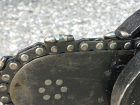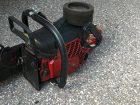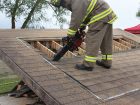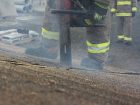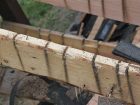
Equipment
Back to Basics: November 2018
Ventilation saws are a great tool to use when cutting open a roof or the side of a gable end for vertical ventilation. They speed up the process, allowing for quicker evacuation of hot gases, smoke and unburned particles of combustion.
October 23, 2018
By Mark van der Feyst
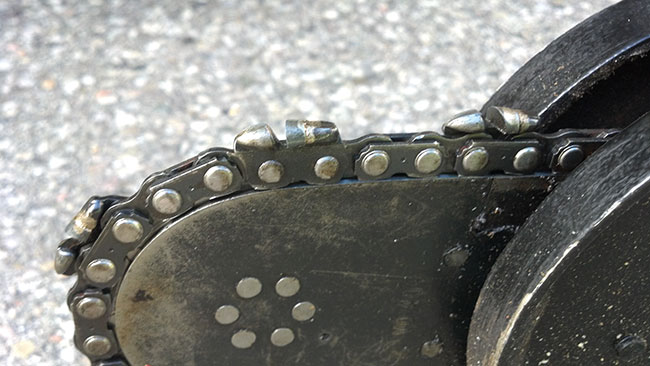
They are also very useful for other special operations such as helping an RIT create an enlarged opening for extrication of a mayday firefighter. Using a ventilation saw requires training on the finer details of how it performs, how to use it correctly and how to optimize it for peak performance.
There are ventilation saws that are manufactured specifically for the fire service and differ greatly from a regular chainsaw used for household or commercial use. The one area where there is a major difference is the type of chain that is used. On a fire service ventilation saw, a specially designed chain called a “bullet chain” is used in place of a regular chain. The bullet chain has a beefier look to it and also has different cutting properties built into it.
The bullet chain needs to be pushed in as opposed to being pulled into the material. The bullet chain produces a fine sawdust as opposed to wood chips that are produced from a regular chain. This is also another way of telling if the ventilation saw has a regular chain or a bullet chain.
The bullet chain will cut through all types of materials when operated at a consistent speed. The speed needed to cut through three inches of material, be it wood, shingles, insulation, plastic or metal pipe, nails or wire, is 74 feet per second. This speed allows the chain to drive through the material. To achieve 74 feet per second, the ventilation saw needs to operate at 10,200 revolutions-per-minute consistently. When the speed drops to 73 feet per second, chain chatter is then created where the chain is bouncing off the material because it does not have the speed or power to cut into and through it. Chain chatter can lead to kickback. The bullet chain has been designed so that it will not produce kickback.
Another distinct feature on a fire service ventilation saw is the exhaust and intake ports. The intake port of the ventilation saw is very distinctive, as it has a black foam cover around the filter. The air intake has been moved to be on top of the saw because it helps with the increase in performance speed and allows the saw to work in environments that are smoke-filled. The air is drawn in from behind the firefighter where it is cooler and cleaner than the air in front of the firefighter. The exhaust port is also on top which blows smoke and heat away from the saw. The exhaust port works in conjunction with the black plate on the front of the saw body to deflect heat and debris up and away.
The ventilation saw also has a depth gauge attached around the bar of the saw, allowing a firefighter to adjust the depth of the cut. This gauge works well when knowledge of a roof’s thickness is known. This can be accomplished by cutting an inspection hole with the gauge set back all the way.
An inspection hole is made by cutting a small triangle in the area of where a vertical vent opening will be made. The triangle cut can be the width of the chain bar and can be made by plunging the blade of the saw straight into a roof in a three-sided fashion.
Remember to operate the saw at full throttle in order to ensure its optimal performance. When the saw is operating at half throttle or thereabouts, the chain will not work as it is intended to and the saw engine will be working a lot harder.
Once the thickness can be observed, the gauge can then be set to cut the roof’s material without cutting the roof joists all the way through. But what if the depth gauge malfunctions? What happens if the silver knob that tightens the gauge becomes loose, falls off or the depth gauge is missing? This can become reality, as vital parts of equipment/tools will sometimes be lost during operation. The saw can still be used to cut the roof without cutting the roof joists all the way through. This is where positioning of the saw while cutting comes into play along with the bullet chain being used in tandem.
A firefighter can hold the ventilation saw vertically as opposed to being on an angle. The vertical position allows the chain on the saw to come into complete contact with the roof joist. The depth of the joist comes into complete full-surface contact with the chain. For example, if the roof joist is two-by-eight inches, then a full 7.5 inches of the wood joist will come into contact with the chain.
Remember that the bullet chain needs to be pushed into the material and will want to repel itself from the material naturally. When the saw is being moved across the roof line during the cut, as it comes into contact with the roof joist, the operator will feel the saw resisting the joist, allowing him or her to bring the saw up to roll over the joist and then plunge it back down. When the saw is on an angle without the depth gauge, the operator will not feel the resistance of the joist and will be more prone to cut all the way through it.
The bullet chain on the saw might make black marks when it comes into contact with a roof joist and might also make a small notch when it rolls over the joist, but it will not compromise the joist as much as it would be if it was cut almost all the way through.
A ventilation saw might look like a regular chain saw, but in many ways the two are completely different, requiring the end user to be familiar with the differences and its performance. Training will accomplish this.
Mark van der Feyst has been a member of the fire service since 1999 and is a full-time firefighter in Ontario. Mark teaches in Canada, United States and India, and is a FDIC Instructor. He is the lead author of the Residential Fire Rescue book. Email Mark at Mark@FireStarTraining.com.
Print this page
